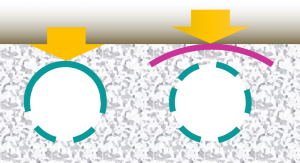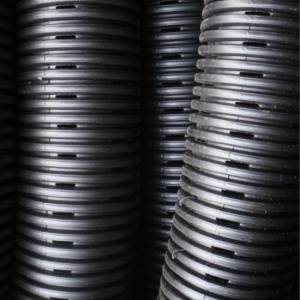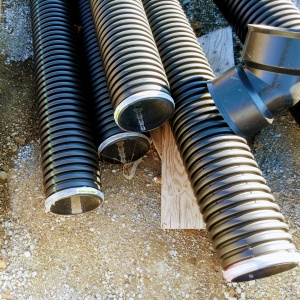Difference between revisions of "Pipes"
Jump to navigation
Jump to search
Jenny Hill (talk | contribs) |
Jenny Hill (talk | contribs) m |
||
| (10 intermediate revisions by the same user not shown) | |||
| Line 1: | Line 1: | ||
| − | [[File: | + | [[File:Perforations.png|thumb|Pipes are available with perforations on just one side, these should be situated on the lower half of the pipe. Pipes with 360° perforations should have a strip of geotextile or membrane placed over the pipe to reduce the migration of fines from overlying media.]] |
| + | Perforated pipes are a common component of [[underdrains]], [[infiltration trenches]] and [[exfiltration trenches]]. | ||
| + | |||
Pipes should have been manufactured in conformity with the latest standards by the Canadian Standards Association (CSA) or ASTM International. | Pipes should have been manufactured in conformity with the latest standards by the Canadian Standards Association (CSA) or ASTM International. | ||
| − | *Perforated pipes should be continuously perforated, smooth interior HDPE (or equivalent material) | + | *Perforated pipes should be continuously perforated, smooth interior HDPE (or equivalent material). |
| − | ** | + | **Wherever possible pipes should be ≥ 200 mm internal diameter to reduce clogging and to facilitate inspections and maintenance. |
| − | ** | + | **Smooth interior facilitates inspection and maintenance activities; internal corrugations can cause cameras or hydrojetting apparatus to become snagged. |
| − | + | **A perforated pipe with many rectangular slots has better drainage characteristics than a pipe with similar open area provided by fewer circular holes <ref>Hazenberg, G., and U. S. Panu (1991), Theoretical analysis of flow rate into perforated drain tubes, Water Resour. Res., 27(7), 1411–1418, doi:10.1029/91WR00779.</ref>. | |
| − | + | *Non-perforated pipes should be used for conveyance to and away from the facility, including [[overflow]]. It is good practice to extend the non-perforated pipe approximately 300 mm within the reservoir or practice to reduce the chance of migration from native soils clogging the pipe at the interface. | |
| − | + | ||
| − | + | <gallery mode="packed" widths=200px heights=200px> | |
| − | + | Perforated Pipe 550x550.jpg|Pipe with slotted perforations | |
| − | *Non-perforated pipes should be used for conveyance to and away from the facility, including overflow. | + | Pipe with connector.jpg|Perforated pipes awaiting installation, note the 30 degree connector used to facilitate maintenance. |
| − | + | </gallery> | |
| + | See also: [[flow through perforated pipe]] | ||
| + | ---- | ||
[[Category:Materials]] | [[Category:Materials]] | ||
Revision as of 18:53, 15 March 2019
Perforated pipes are a common component of underdrains, infiltration trenches and exfiltration trenches.
Pipes should have been manufactured in conformity with the latest standards by the Canadian Standards Association (CSA) or ASTM International.
- Perforated pipes should be continuously perforated, smooth interior HDPE (or equivalent material).
- Wherever possible pipes should be ≥ 200 mm internal diameter to reduce clogging and to facilitate inspections and maintenance.
- Smooth interior facilitates inspection and maintenance activities; internal corrugations can cause cameras or hydrojetting apparatus to become snagged.
- A perforated pipe with many rectangular slots has better drainage characteristics than a pipe with similar open area provided by fewer circular holes [1].
- Non-perforated pipes should be used for conveyance to and away from the facility, including overflow. It is good practice to extend the non-perforated pipe approximately 300 mm within the reservoir or practice to reduce the chance of migration from native soils clogging the pipe at the interface.
See also: flow through perforated pipe
- ↑ Hazenberg, G., and U. S. Panu (1991), Theoretical analysis of flow rate into perforated drain tubes, Water Resour. Res., 27(7), 1411–1418, doi:10.1029/91WR00779.


